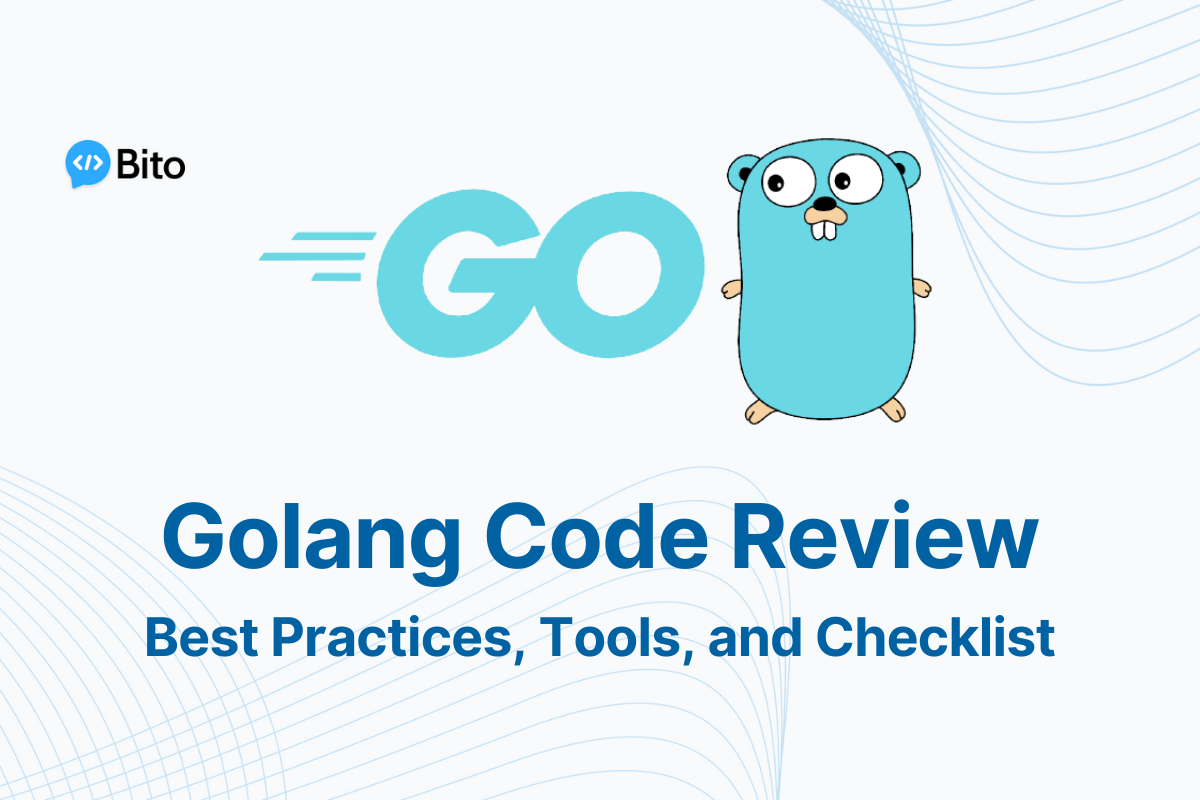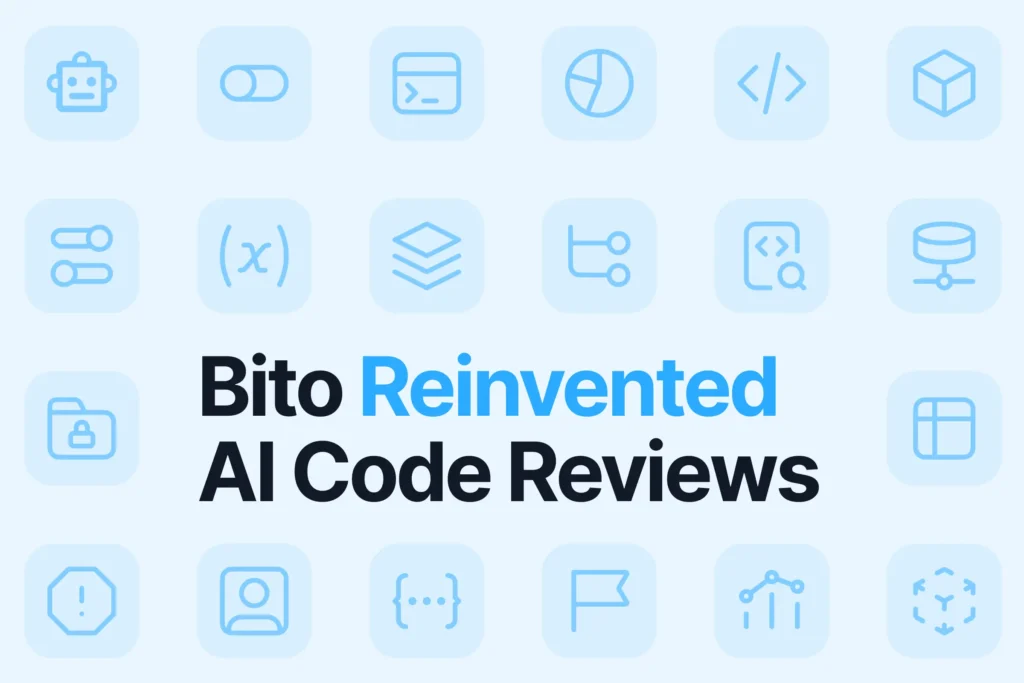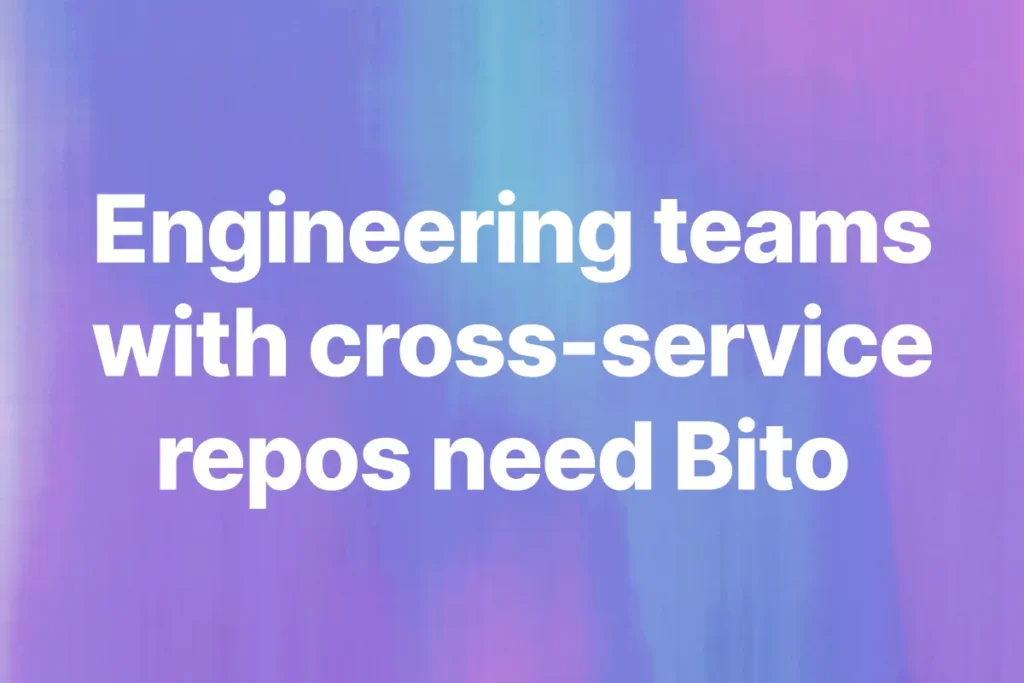What is a Golang code review?
A Golang code review is a structured peer-review process where developers inspect Go code before it’s merged into the main branch. The purpose is to catch bugs, ensure code quality, maintain performance, and enforce idiomatic Go conventions.
Unlike reviews in languages with more syntactic noise, Go reviews emphasize clarity, explicit logic, and safe concurrency. The simplicity of Go’s syntax doesn’t eliminate complexity—it just shifts it to the architectural and concurrency levels, where human review is still essential.
Modern teams enhance this process using AI-powered tools like Bito, which augment traditional review workflows. These tools can catch logic errors, anti-patterns, and missed best practices before code reaches a human reviewer—leading to cleaner pull requests and fewer production issues.
Once the role of reviews is understood, the next question is—who’s responsible for them in a Go team?
Who performs code reviews in Go teams?
In Go teams, code reviews are handled by developers with domain knowledge or ownership of the feature being modified. This often includes senior engineers, tech leads, or rotating reviewers assigned to the code area.
Mid-level and junior developers also participate in reviews for shared context and continuous learning. Review responsibilities should be distributed intentionally—not left to whoever’s available—because consistent reviewer context leads to better feedback.
Some teams incorporate AI code review tools like Bito to automate first-level reviews. These agents can handle repetitive checks and surface issues proactively, especially helpful for high-volume teams or open-source maintainers managing many pull requests.
While tools can assist, the human layer remains critical for evaluating architectural fit and intent. Knowing when to perform reviews is the next lever to keep quality high and velocity stable.
When should you perform code reviews?
Code reviews should occur before merging any non-trivial changes into your main branch. Ideally, they’re triggered automatically when a pull request is opened.
Key times to perform a review:
- Before merging a new feature or refactor
- After architectural changes or dependency updates
- Before creating release branches
- When onboarding new contributors
Timely reviews prevent context switching and reduce merge conflicts. Review delays are one of the main causes of stalled sprints in fast-paced Go teams.
Teams using CI pipelines should ensure formatting, linting, and automated testing occur as soon as code is pushed. Automated pre-checks reduce the review burden by ensuring only clean code reaches human reviewers.
But before submitting for review, code must be properly prepared.
How to prepare Go code for review
Submitting unpolished code wastes time for everyone involved. Developers should clean up their changes, write relevant tests, and run tooling before pushing a pull request.
Key preparation steps:
- Format code using
gofmtandgoimports - Run static analyzers like
staticcheckanderrcheck - Add meaningful unit tests or integration tests
- Remove commented-out code and debugging leftovers
- Write a clear, concise PR description
Tools like Bito’s AI Code Review Agent can automatically catch logic issues, inconsistent patterns, and missed conventions before a human ever sees the diff. This improves the quality of the initial submission and speeds up the review cycle.
With the code ready, reviewers need a clear set of criteria to evaluate it effectively.
Key criteria in a Golang code review
A strong review evaluates more than just syntax. Reviewers should look at logic, performance, idiomatic usage, and maintainability.
What reviewers should assess:
- Logic correctness: Does the code behave as expected? Are edge cases covered?
- Error handling: Are errors wrapped, logged, or surfaced correctly?
- Concurrency safety: Are shared resources synchronized? Are goroutines managed safely?
- Readability: Is the code understandable without excessive mental overhead?
- Testability: Can the logic be tested independently? Are the tests meaningful?
- Performance: Are memory allocations, loops, or I/O operations efficient?
Comments should aim to improve—not criticize. Focus on alternatives and explain why a change improves the outcome. Avoid subjective nitpicks unless backed by a team style guide.
To make reviews consistent, many teams use a checklist.
Recommended checklist for Golang code reviews
A checklist improves review quality by standardizing the expectations across engineers. It reduces the chance of missing critical issues during rushed reviews.
✅ Code correctness
- Business logic behaves as intended
- Handles edge cases and unusual inputs
- Avoids magic values or unclear constants
✅ Formatting and structure
- Passes
gofmtandgoimports - Well-structured imports and consistent indentation
- Code grouped logically
✅ Idiomatic Go
- Uses short declarations (
:=) where suitable - Interfaces are defined only when necessary
- Slices, maps, and channels used idiomatically
✅ Error handling
- Errors are wrapped using
fmt.Errorforerrors.Join - External calls are checked for
nilresponses - No swallowed or silent errors
✅ Concurrency
- Uses
context.Contextfor goroutine control - Avoids unsafe access to shared memory
- Proper use of
select, channels, and mutexes
✅ Testing
- Unit tests cover core logic paths
- Table-driven tests used for clarity
- Fakes/mocks used appropriately
This checklist should be adapted based on your domain. Tools can help enforce parts of it automatically.
Which brings us to the tooling that can elevate your review workflow.
Best tools for Golang code review
Using the right tools reduces friction and ensures repeatable quality. Most Go teams use a mix of linters, analyzers, and review platforms.
| Tool | Type | Key strengths |
|---|---|---|
| Bito’s AI Code Review Agent | AI Reviewer | Reviews logic, performance, and correctness; CI-ready suggestions |
golint | Linter | Flags style and naming issues |
staticcheck | Static Analyzer | Detects bugs, simplifications, and deprecated usage |
GoMetaLinter | Aggregator | Runs multiple linters in parallel |
goreview | CLI Utility | Lightweight review feedback tool |
Review Board | Review Platform | Web-based interface for inline feedback and multi-reviewer workflows |
Bito adds value beyond static tools by interpreting intent and code behavior. It helps identify edge-case logic issues, race conditions, or unnecessary complexity—something basic linters cannot catch.
Even with great tools, knowing how to give effective feedback is just as important.
How to review Golang code effectively
Effective reviews prioritize clarity, empathy, and engineering value. The goal isn’t just correctness—it’s building shared understanding.
Best practices for reviewers:
- Start by reading the full diff before commenting
- Ask questions when confused: “Is this pattern reused elsewhere?”
- Avoid absolutes unless tied to known team standards
- Suggest alternatives with reasoning
- Reinforce good practices by calling them out
Don’t waste energy on style issues that gofmt enforces. Focus on logic, test coverage, and system implications.
Go makes it easy to write readable code—but reviewing still requires attention to the language’s design decisions.
How Go’s design affects the review process
Go’s simplicity reduces ceremony, but it puts pressure on design clarity and reviewer attention.
Design traits that impact reviews:
- Gofmt is mandatory: Reviewers can ignore style debates and focus on substance
- Interfaces are implicit: Reviewers must verify interface satisfaction by usage, not declaration
- Concurrency is powerful and dangerous: Goroutines, channels, and locks must be carefully reviewed
- Error handling is explicit: Omissions are visible, but verbosity can cause fatigue—reviewers must stay alert
Go doesn’t hide complexity. It makes it visible. This transparency makes reviews more impactful—if you handle pull requests correctly.
Handling pull requests in Go projects
Pull requests (PRs) are your first defense against regressions and design creep. PRs that are clear, focused, and well-documented lead to faster, better reviews.
What strong PRs look like:
- Tightly scoped to a single concern
- Descriptive titles and commit messages
- Linked to tickets or issues when applicable
- Include tests and test data
- Have no unrelated formatting or structural changes
Automated checks should run on every PR. CI should validate formatting, linting, test success, and code coverage before human review begins.
Poor PR hygiene slows everything down. It’s the responsibility of both submitters and reviewers to keep things maintainable.
Even with good PRs, some problems can still slip through. That’s where awareness of common pitfalls helps.
Common mistakes in Go code reviews
Even experienced reviewers miss issues. Knowing what often gets overlooked can help improve review quality across the board.
Common review gaps:
- Race conditions in goroutines or shared memory
- Unhandled or silently ignored errors
- Overuse of interfaces with a single implementation
- Bloated functions with unclear responsibilities
- Inefficient slice growth or unbounded memory allocations
- Untested negative cases or edge conditions
These aren’t always obvious. Review checklists help, but nothing replaces experience and shared team context.
Creating a healthy review culture helps engineers catch these issues early.
Building a review culture in Go teams
Strong teams treat reviews as part of engineering, not a gatekeeping process. Building a productive review culture requires clarity, empathy, and structure.
Ways to build that culture:
- Maintain a shared Go style guide for team decisions
- Rotate reviewers to build shared ownership
- Pair junior reviewers with experienced engineers for feedback loops
- Focus on constructive feedback, not criticism
- Use AI tools like Bito to standardize early feedback and reduce rework
Culture scales quality. With good culture, even automation becomes more effective.
Automating Golang code reviews
Automating routine checks makes the review process faster, more consistent, and less error-prone.
What to automate:
gofmtandgoimportsfor formattinggolangci-lintorstaticcheckfor static analysis- Code coverage thresholds using tools like
go test -cover - Pre-merge testing and linting via GitHub Actions or GitLab CI
- Optional AI review using Bito for logic and style analysis
Automation can’t replace human judgment—but it ensures reviewers spend their time where it matters most.
That same automation approach is widely used in Go’s open-source ecosystem.
How open source Go projects manage reviews
Projects like Kubernetes, Docker, and Prometheus have high review standards. Their workflows offer excellent models for teams of any size.
Common open-source practices:
- Use bots for reviewer assignment and label management
- Enforce formatting and testing before merge
- Require explicit LGTM (Looks Good To Me) approvals from multiple reviewers
- Favor small, incremental pull requests over sweeping changes
- Use clear ownership boundaries for faster triage
These practices reduce friction and improve collaboration. Even internal teams can replicate them for better structure.
Once systems are in place, measuring their impact becomes essential.
Key metrics to measure code review quality
Tracking review metrics helps identify bottlenecks, improve throughput, and maintain quality under growth.
Metrics to monitor:
- Time to first review: Long delays increase context loss and lower code quality
- Time to merge: Helps assess velocity and review friction
- Churn rate: High post-merge edits suggest inadequate initial review
- Review coverage: Percentage of code changes reviewed or commented on
- Defect density: Bugs found per 1,000 lines of merged code
- AI vs. human comments: Track which issues are being caught where
Metrics should guide process improvement, not be weaponized. Use them to refine onboarding, allocate review bandwidth, or tune automation settings.
Why effective code reviews matter in Golang
Go enables teams to build fast, efficient software—but only if the codebase remains clean, readable, and safe. That’s where code reviews come in.
A strong review process helps:
- Reduce production bugs and incident volume
- Improve test coverage and confidence
- Promote team-wide design consistency
- Speed up onboarding by keeping the codebase predictable
In Go, where minimalism meets concurrency, a small oversight can become a serious issue in production. Code reviews are how teams protect themselves from that risk while building better software together.
FAQs about Golang code reviews
What is the purpose of a code review in Go?
The purpose of a code review in Go is to identify bugs, improve code clarity, ensure idiomatic usage, and maintain performance. It also supports knowledge sharing, enforces architectural patterns, and improves maintainability across the codebase.
What should be included in a Golang code review checklist?
A solid checklist should include logic correctness, error handling, Go formatting (gofmt), concurrency safety, idiomatic syntax, function complexity, and test coverage. Tools and automation should be used to enforce many of these items consistently.
How do tools like Bito enhance Golang code reviews?
Bito uses AI to analyze Go code for logic flaws, anti-patterns, concurrency risks, and maintainability issues. Unlike traditional linters, it provides contextual suggestions, helping developers fix problems before human review begins.
How can Go teams handle large or complex pull requests?
Large pull requests should be split into smaller, logically grouped changes. Each PR should focus on a single concern. Complex changes require thorough documentation, clear commit messages, and potentially more reviewers to share the review load.
Should you automate all parts of the code review?
Not entirely. Format checks, linting, test runs, and even AI-based static analysis can be automated. However, design decisions, architectural trade-offs, and business logic correctness still require human judgment.
How often should teams revisit their code review process?
Review your code review process quarterly or after major incidents. Metrics like defect density, review latency, and churn rates will show when workflows need to evolve. Also revisit when onboarding new tools or scaling teams.
How do open-source Go projects maintain review quality?
They rely on bots, mandatory CI checks, review templates, and enforced ownership boundaries. Reviews are public and small in scope, which keeps the quality bar high and enables scalable, transparent collaboration.
Conclusion
Effective code reviews in Golang are not about perfection—they’re about consistency, clarity, and risk reduction. Go’s simplicity means reviewers must focus on what matters: correctness, concurrency, testability, and idiomatic usage.
Combining strong human review culture with automation and AI support leads to faster iterations and more robust systems. Tools like Bito help enforce quality at scale, but human insight remains irreplaceable.
A great Go codebase isn’t just written well—it’s reviewed well.






